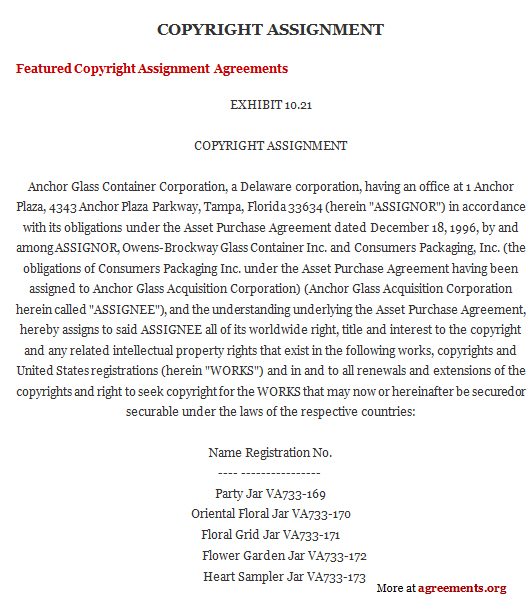What is a Copyright Assignment Agreement?
When the creator of a specific work decides to transfer the ownership rights to another individual or firm, both parties enter into a ‘copyright assignment agreement’ This legal document contains the provisions of transfer in writing and is signed by the owner or his/her authorized agent.
Who Are the Parties to Such an Agreement?
A creator/owner of a work (as outlined in the previous section), who seeks to protect their innovation from being copied, enters into a copyright assignment agreement. For example, a website owner might want to enter into such an agreement to ensure that his/her identity as the creator of the work is duly recognized when another individual uses the same.
The other party which enters into the agreement is one that seeks to use another person’s content. For example, seeking to use an individual’s movie, prose or poetry, or say voice recording in pursuance of your own idea.
What is the purpose of a Copyright Assignment Agreement?
- Copyright agreements are essential to reward and protect the creativity of authors over their creations. It is widely understood that creativity is one of the core parameters of progress, and hence, economic and social enhancement depends on the same.
- To motivate other creative individuals to bring out innovations in various fields such as technology and arts. When the creative control of an individual is awarded, it develops a conducive atmosphere for other creators of intellectual property.
What Are the Contents of a Copyright Assignment Agreement?
- Date: Depending on the laws of the State, the date of commencement and termination of the copyright agreement are mentioned. For example, in the case of copyrighted work in India, the duration is 60 years. When such time is not specified, ‘until either party provides written notice of termination to the other party. Such written notice should be of a prior stipulated period.
- Rights and Obligations: This includes the rights of the owner of the copyrighted property: proprietary rights, rights of subsequent usage, and licensing and assignment of copyrights.
- Royalty: A copyright assignment agreement also provides for payment of royalty to the original copyright holder. Such royalties are often mutually negotiated and decided.
- Warranties and Representation: This clause puts forth the various warranties and representations which the parties may wish to include. Hence, confirmations such as the party assigning the copyright is actually the holder of the same, and the opposite party will be compliant with the law while using the same will be included under this clause.
- Assignment: A copyright is typically assignable and can be transferred. Sometimes a separate copyright transfer agreement may be required for the same.
- Dispute resolution: The method and forum of dispute resolution should be clearly included in the agreement.
How to Draft a Copyright Assignment Agreement?
What points should be kept in mind while drafting the same?
A copyright template should be drafted, following the given guidelines:
- The first essential for an assignment agreement is the existence of copyright for the property in consideration for the transfer.
- There should be a complete understanding of the copyright laws of the land. In most cases, parties engage a legal consultant to advise them on the nitty-gritty of a copyright assignment.
- To draft an assignment agreement, there must be clarity as to the extent of usage of the assigned copyright. Most conflicts between parties in such cases arise due to lack of lucidity with respect to the duration, terms of use and creative control over the work. Such details must be covered in the agreement, as simplistically as possible.
Benefits and Drawbacks of a Copyright Assignment Agreement?
Benefits:
- A copyright holder is normally the person who created the work, say a music producer or a singer. More often than not, such individuals do not have the capacity to reach a larger audience on their sole capacity. Entering into an assignment agreement allows them to seek wider publicity and financial gains through the business model of a party which is already well-established in the field.
Drawbacks:
- When copyright is assigned, the owner might actually receive a cut of what s/he could have actually received in case of sole ownership. This deals with the financial profit, which could have been earned by a creator on his/her own accord.
- Second, there is a loss of creative control. For example, the owner might now not have control over whether his/her book would be turned into a movie or not.
What Happens in Case of Violation?
In case of infringement by either party of the assignment agreement, the grant of damages is generally meant to restore the position of the plaintiff in which he/she would have been if the infringement in question did not take place. In the case of flagrant violation of the assignment agreement, there can be a grant of punitive or exemplary damages.
The rising costs of copyright violation cases raise doubts on the feasibility of assignment agreements. While they provide pecuniary and distribution benefits to the owners of the copyright, there are graver consequences with respect to misuse of such arrangements. What is needed today is greater research into this inevitable necessity of the dynamic commercial world; by tapping into the potential of creative minds across geographical boundaries, there must be a more efficient realization of the benefits of the assignment contracts.
You can Download the Free Copyright Assignment Agreement customize it according to your needs and Print. Copyright Assignment Agreement is either in MS Word, Excel or in PDF.
Sample Copyright Assignment Agreement
